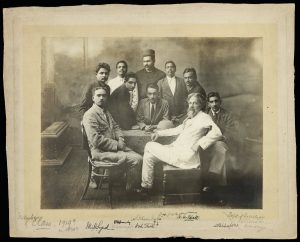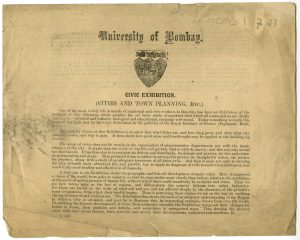Our project archivist, Elaine MacGillivray, travels to India later this week to deliver presentations at the CEPT Archives (Architecture, Planning and Design) in Ahmedabad, and at the ARTISANS’ gallery in Mumbai. In advance of touch-down in India, we take a brief look at Geddes’ experience there.

Patrick Geddes and class of c1919, University of Bombay Department of Sociology and Civics (Ref: Coll-1869/11)
Patrick Geddes first travelled to India in the autumn of 1914. He was 60. Prompted by the success of Geddes’ urban regeneration projects in the Edinburgh Old Town, Lord Pentland, (the then Governor of Madras), had invited Geddes to travel to India to advise on urban planning issues. In that first of many seasons that Geddes was to spend in India he was accompanied by his eldest son Alasdair. Together, they travelled thousands of miles across the vast country, all the time surveying each of the cities they visited. After arriving at Bombay, they headed north to Ahmedabad, Ajmer, Jaipur, Agra and to New Delhi before travelling across India to Lucknow, Cawnpur, Allahabad, Benares, Calcutta and then southward to Madras.
Geddes had planned to show in India, his favoured tool of civic education, the Cities and Town Planning Exhibition. He faced an unfortunate setback when the ship transporting his exhibition to India, the Clan Grant, was sunk near Madras by the German ship, the Emden. Aided by friends and colleagues at home, a committee, led by H.V. Lanchester, collected and forwarded a replacement exhibition. The first shipment made it to Madras by December 1914. The exhibition, comprising over 3000 maps, prints and photographs and set out on a quarter-mile of wall and screen, opened at the Senate Hall of Madras University on 17 January 1915. Geddes went on to tour his Cities and Town Planning Exhibition across India. The exhibits make up much of the Patrick Geddes archive collections now held at the universities of Edinburgh and Strathclyde.

An example of the plethora of notes made by Patrick Geddes’ on India, its cities, institutions and culture (Ref:T-GED/12/1/191a)
Geddes worked tirelessly to survey and compose reports on Indian cities and towns, 13 alone in Madras. Lewis Mumford, in his introduction to Jaqueline Tyrwhitt’s Patrick Geddes in India (1947), wrote that throughout Geddes’ time in India he worked to promote his ‘broad humanistic outlook on the social aspects of civic improvement’.[1] To quote Geddes himself ‘town-planning is not mere place-planning, nor even work-planning. If it is to be successful, it must be folk-planning’.[2]
The measure of the success of a city survey depends on its appeal to the individuals that compose the city: upon its power to rouse each from his, often life-long, training of seeing himself as a self-interested economic man and therefore mere dust of the State – to realising himself as an effective citizen valuing…his contribution to his city, in his city and for his city.[3]

Cities and Town Planning Exhibition at University of Bombay (Ref: T-GED/1/7/21a)
After a season of touring the Cities and Town Planning Exhibition, surveying and reporting on Indian cities, Geddes returned to Scotland in the summer of 1915 to fulfil his teaching responsibilities as Chair of Botany at the University College Dundee. Thereafter, he continued to travel to India each autumn. In 1917 he was prevented from travelling home to Scotland due to the dangers of being attacked by German U-boats. Geddes, at this point, was accompanied by his wife Anna and together they planned a summer school in Darjeeling. They recruited renowned Bengali polymath, poet, musician and artist, Rabindranath Tagore. The school opened on 21 May 1917, and marks the beginning of Geddes and Tagore’s friendship.
It was in India in 1917 that Geddes was dealt the harshest of blows. In April, he received a telegram to advise that his eldest son Alasdair had been killed in action in France. He bore this news alone for four months, afraid that sharing the news with his dear wife Anna would accelerate her own illness. Devastatingly, his dearly beloved and stalwart companion, Anna, died at Calcutta in the summer of 1917. She was unaware that she had been predeceased by her son.
Bereft, Geddes continued to work tirelessly to survey and report on Indian Cities, advocating and adapting his ideas on ‘diagnosis before treatment’, ‘conservative surgery’, and ‘regional survey for regional service’ to Indian traditions and values. His attempt to study and understand the interaction between humans and their environment utilised a range of disciplines including biology, sociology, geography, geology, and town planning. Sometimes he would only spend one or two swift days surveying a city. In others cases, as for Indore, he would spend months, culminating in a two-volume planning report, published in 1918.
Geddes returned to Scotland for a period in 1919. In the summer of 1919, he was offered the Chair of Sociology and Civics at the University of Bombay, by the then vice-chancellor, Sir Chimanlal Setalvad. Now at the age of 65, Geddes accepted the offer. By 1924, Geddes’ health had deteriorated and his contract with the University of Bombay was to come to an end. The success or otherwise of Geddes’ terms at the University of Bombay are debated. Certainly, there is evidence that the University Senate expressed dissatisfaction at Geddes’ periods of absence (in some part due to his town-planning commitments in Palestine). Geddes left India in 1924 and settled in Montpellier in the south of France.
For more in-depth accounts of Patrick Geddes in India you may find the following publications a useful starting point:
- Boardman, P., The Worlds of Patrick Geddes, (1978)
- Fraser, B., A meeting of two minds: Geddes Tagore letters, (2005)
- Tyrwhitt, J., Patrick Geddes in India, (1947)
- Munshi, I., Patrick Geddes: Sociologist, Environmentalist and Town Planner, Economic and Political Weekly, Vol. 35, No. 6 (5-11 Feb 2000), pp.485-491
Elaine will be delivering presentations at the CEPT Auditorium, Ahmedabad on 1 March 2019, and at ARTISANS’, Mumbai on 5 March 2019. For further information please contact Elaine elaine.macgillivray@ed.ac.uk
[1] Tyrwhitt, J., Patrick Geddes in India, (1947), p.16.
[2] Ibid., p.22.
[3] Ibid., p.35.

I was fortunate to have attended this lecture at CEPT. Elaine’s presentation was extremely informative for us, who follow PG’s works in India.